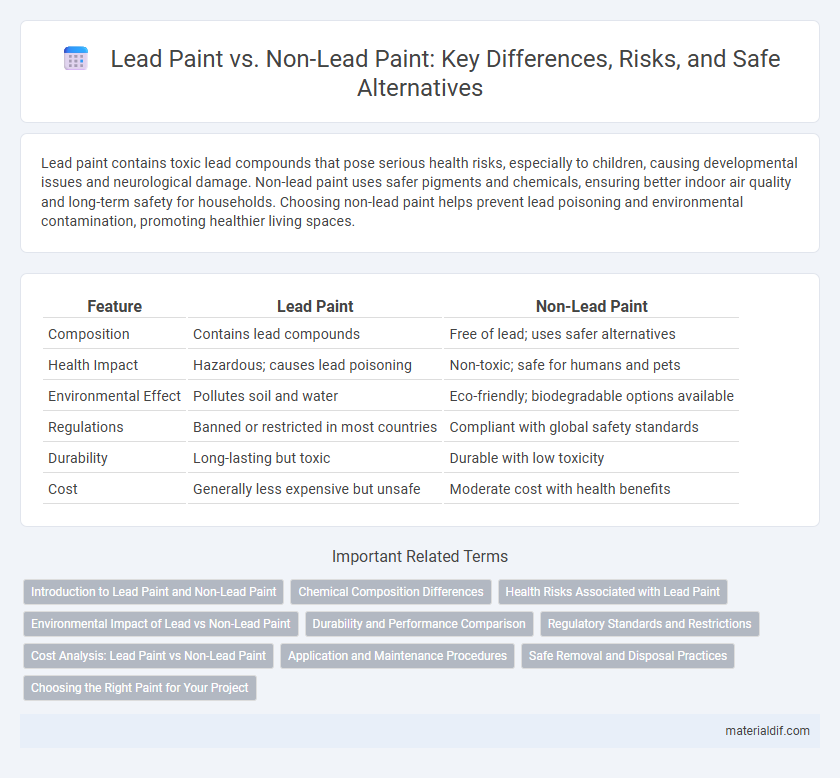Lead paint contains toxic lead compounds that pose serious health risks, especially to children, causing developmental issues and neurological damage. Non-lead paint uses safer pigments and chemicals, ensuring better indoor air quality and long-term safety for households. Choosing non-lead paint helps prevent lead poisoning and environmental contamination, promoting healthier living spaces.
Table of Comparison
| Feature | Lead Paint | Non-Lead Paint |
|---|---|---|
| Composition | Contains lead compounds | Free of lead; uses safer alternatives |
| Health Impact | Hazardous; causes lead poisoning | Non-toxic; safe for humans and pets |
| Environmental Effect | Pollutes soil and water | Eco-friendly; biodegradable options available |
| Regulations | Banned or restricted in most countries | Compliant with global safety standards |
| Durability | Long-lasting but toxic | Durable with low toxicity |
| Cost | Generally less expensive but unsafe | Moderate cost with health benefits |
Introduction to Lead Paint and Non-Lead Paint
Lead paint contains toxic lead compounds that pose serious health risks, especially to children and pregnant women, causing neurological damage and developmental delays. Non-lead paint uses safer alternatives like titanium dioxide or calcium carbonate as pigments, eliminating exposure to harmful heavy metals. Understanding the composition and hazards of lead paint guides safer renovation and painting decisions for indoor and outdoor environments.
Chemical Composition Differences
Lead paint contains lead compounds such as lead carbonate or lead chromate, which enhance durability and pigmentation but pose severe health risks due to lead toxicity. Non-lead paint utilizes alternative pigments and binders, such as titanium dioxide and organic compounds, offering safer environmental and health profiles without sacrificing color vibrancy or finish quality. Chemical differences significantly impact regulatory standards, making non-lead paint the preferred choice in modern architectural and industrial applications.
Health Risks Associated with Lead Paint
Lead paint contains high levels of toxic lead, which poses significant health risks such as neurological damage, developmental delays, and respiratory issues, especially in children and pregnant women. Exposure occurs through ingestion or inhalation of lead dust and chips from deteriorating or disturbed lead-based paint surfaces. Non-lead paint eliminates these hazards, making it a safer alternative for residential and commercial use, reducing the risk of lead poisoning and associated chronic health complications.
Environmental Impact of Lead vs Non-Lead Paint
Lead paint releases toxic lead particles into the environment, contaminating soil and water, which poses severe risks to wildlife and human health. Non-lead paint formulations utilize safer compounds that reduce environmental pollution and prevent bioaccumulation of heavy metals. The widespread use of non-lead paint significantly lowers ecological damage and supports sustainable habitat conservation.
Durability and Performance Comparison
Lead paint offers superior durability due to its ability to resist moisture, mildew, and cracking, making it last longer in harsh environments compared to non-lead paint. Non-lead paint, while safer and environmentally friendly, often requires more frequent maintenance and recoating because it lacks the same level of resistance to wear and tear. Advances in non-lead formulations have improved performance, but lead paint remains the benchmark for longevity in industrial and high-performance applications.
Regulatory Standards and Restrictions
Lead paint is subject to strict regulatory standards due to its toxic effects, with agencies such as the U.S. Environmental Protection Agency (EPA) and the Consumer Product Safety Commission (CPSC) limiting lead content to 90 parts per million (ppm) in residential paints. Non-lead paints comply with these regulations, using safer alternatives that do not pose health risks associated with lead exposure, such as neurodevelopmental damage in children. Worldwide, many countries have banned lead-based paints entirely, enforcing compliance through periodic testing and heavy penalties for violations to ensure public safety.
Cost Analysis: Lead Paint vs Non-Lead Paint
Lead paint typically costs less upfront compared to non-lead paint due to cheaper raw materials and manufacturing processes. However, non-lead paint often results in lower long-term expenses by eliminating health risks, reducing remediation costs, and complying with stricter environmental regulations. Cost analysis must factor in potential liabilities and maintenance when choosing between lead and non-lead paint options.
Application and Maintenance Procedures
Lead paint requires specialized application techniques involving protective gear and strict ventilation controls to avoid hazardous lead dust exposure, with maintenance demanding careful containment and professional removal methods. Non-lead paint offers easier application without health risks, allowing standard surface preparation, application tools, and routine cleaning processes. Maintenance of non-lead paint involves simple touch-ups and repainting without the extensive safety measures necessary for lead-based coatings.
Safe Removal and Disposal Practices
Safe removal of lead paint requires using specialized protective equipment such as respirators and disposable suits to prevent inhalation and ingestion of toxic dust. Non-lead paint removal is less hazardous but still benefits from proper containment methods to minimize environmental impact. Disposal of lead paint waste must follow EPA guidelines, ensuring hazardous materials are sealed in approved containers and taken to certified facilities, while non-lead paint residues are typically managed through standard waste disposal protocols.
Choosing the Right Paint for Your Project
Choosing the right paint for your project involves weighing the benefits and risks of lead paint versus non-lead paint. Lead paint, historically valued for its durability and moisture resistance, poses significant health hazards including lead poisoning, especially in children and pregnant women. Non-lead paint offers a safer alternative with advanced formulations that provide strong adhesion, vibrant colors, and environmental compliance, making it the preferred choice for residential and commercial projects prioritizing health and safety standards.
Lead Paint vs Non-Lead Paint Infographic

 materialdif.com
materialdif.com